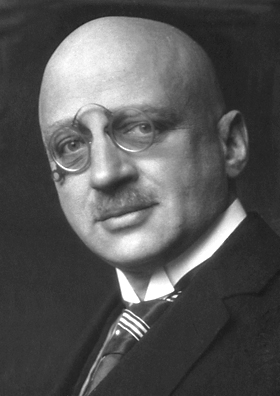Fritz Haber (Fritz Haber)

During his time at University of Karlsruhe from 1894 to 1911, Fritz Haber and his assistant Robert Le Rossignol invented the Haber–Bosch process, which is the catalytic formation of ammonia from hydrogen and atmospheric nitrogen under conditions of high temperature and pressure. This discovery was a direct consequence of Le Châtelier’s principle, announced in 1884, which states that when a system is in equilibrium and one of the factors affecting it is changed, the system will respond by minimizing the effect of the change. Since it was known how to decompose ammonia on nickel based catalyst, one could derive from Le Châtelier’s principle that that reaction could be reversed to produce ammonia at high temperature and pressure (a process that Henry Louis Le Châtelier had even tried himself but gave up after his technician almost killed himself, due to an oxygen intake related explosion). To further develop the process for large-scale production ammonia, Haber turned to industry. Teaming with Carl Bosch at BASF, the process was successfully scaled-up to produce commercial quantities of ammonia. The Haber–Bosch process was a milestone in industrial chemistry. The production of nitrogen-based products such as fertilizer and chemical feedstocks, previously dependent on acquisition of ammonia from limited natural deposits, now became possible using an easily available, abundant base – atmospheric nitrogen. The ability to produce much larger quantities of nitrogen-based fertilizers in turn supported much greater agricultural yields and prevented billions of people from starving to death.
The discovery of a new way of producing ammonia had other significant economic impacts as well. Chile had been a major (and almost unique) producer of natural deposits such as sodium nitrate (caliche). After the introduction of the Haber process, naturally extracted nitrate production in Chile fell from 2.5 million tons (employing 60,000 workers and selling at US$45/ton) in 1925 to just 800,000 tons, produced by 14,133 workers, and selling at $19/ton in 1934. The annual world production of synthetic nitrogen fertilizer is currently more than 100 million tons. The food base of half of the current world population is based on the Haber–Bosch process. Fritz Haber was awarded the 1918 Nobel Prize in Chemistry for this work (he actually received the award in 1919). Fritz Haber was also active in the research on combustion reactions, the separation of gold from sea water, adsorption effects, electrochemistry, and free radical research (see Fenton’s reagent). A large part of his work from 1911 to 1933 was done at the Kaiser Wilhelm Institute for Physical Chemistry and Electrochemistry at Berlin-Dahlem. In 1953, this institute was renamed for him. He is sometimes credited, incorrectly, with first synthesizing MDMA (which was first synthesized by Merck KGaA chemist Anton Köllisch in 1912).
Born
- December, 09, 1868
- Breslau, Prussia
Died
- January, 29, 1934
- Basel, Switzerland
Cause of Death
- heart failure
Cemetery
- Friedhof am Hornli
- Basel, Switzerland


